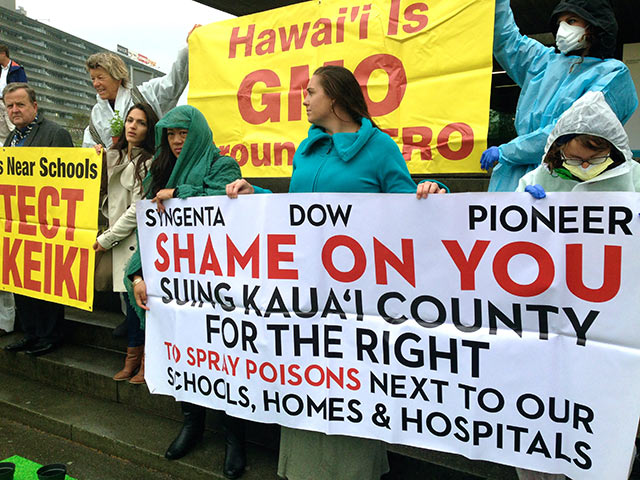
In the Belly of the Chemical Beast: Hawaiian Activists Confront Syngenta on Its Home Turf
I first met Malia Chun in late 2013, in front of her home on the Hawaiian island of Kaua'i, where she pointed between the houses across the street to a nearby field where the agrichemical giant Syngenta tests and produces genetically engineered corn treated with a considerable amount of pesticide.
I met up with Chun again a year and a half later, this time in Syngenta's front yard in Basel, Switzerland. After a short ride through winding, medieval streets on the city's famously punctual public transit, we took pictures outside the tall office building that serves as Syngenta's global headquarters, where a security guard told us we had no chance of getting inside without an employee escort.
May 14, 2015 | Source: Truthout | by Mike Ludwig
I first met Malia Chun in late 2013, in front of her home on the Hawaiian island of Kaua’i, where she pointed between the houses across the street to a nearby field where the agrichemical giant Syngenta tests and produces genetically engineered corn treated with a considerable amount of pesticide.
I met up with Chun again a year and a half later, this time in Syngenta’s front yard in Basel, Switzerland. After a short ride through winding, medieval streets on the city’s famously punctual public transit, we took pictures outside the tall office building that serves as Syngenta’s global headquarters, where a security guard told us we had no chance of getting inside without an employee escort. Unimpressed, Chun asked two university students sitting nearby if they were familiar with Syngenta. The students said they knew that Syngenta sold pesticides, and that a few weeks ago, demonstrators had hung a sign from the building in protest of chemicals thought to harm bees.
“Are you from Greenpeace?” one of the students asked.
“No,” Chun replied. “I am from Hawai’i.”
Traveling with a small delegation from her island, Chun came halfway around the world to confront Syngenta as both a mother and a practicing teacher of Native Hawaiian culture. Chun and others in her community suspect the pesticides may be responsible for an uptick in health problems such as asthma and birth defects, including several cases where babies were born with their intestines outside of their bodies. “As far as pesticide exposure goes, it’s most harmful to children, both born and unborn,” Chun said. “It’s also a direct desecration of our culture.”
For the past three years, a growing coalition of activists and civic leaders on Kaua’i has been battling Syngenta and three other agrichemical companies – BASF, DuPont Pioneer and Dow AgroSciences – over toxic pesticides the companies spray as they field test and produce genetically engineered seeds, which are also known as genetically modified organisms or GMOs. The four companies spray thousands of gallons of pesticides labeled “restricted use” by the United States Environmental Protection Agency (EPA) at their farms and test plots on Kaua’i each year. At least five of the 22 restricted-use pesticide formulas used on the island contain chemicals that have been banned in Switzerland due to environmental and human health concerns, but are perfectly legal in the United States as long as they are applied by licensed workers.
In November 2013, after a year of fierce public debate that galvanized an anti-biotech movement on Kaua’i and divided an otherwise tight-knit island community, the Kaua’i County Council passed Ordinance 960, a law aimed at regulating restricted-use pesticides at a local level. The four companies, along with a local coffee producer, would have been required to observe buffer zones around schools and hospitals, publicly disclose the pesticides they use, and notify neighboring communities about when and where the chemicals would be sprayed, so, as Chun says, “we can close our windows.” An environmental impact study would have been conducted to determine if the pesticides are impacting local ecosystems and contributing to a suspected uptick in birth defects and other health problems in neighborhoods near the agribusiness fields on Kaua’i’s west side.
“It’s a small law,” said Gary Hooser, a county councilmember who authored Ordinance 960 and traveled with Chun to Basel. “Just tell us what you are spraying, and don’t do it next to schools.”
